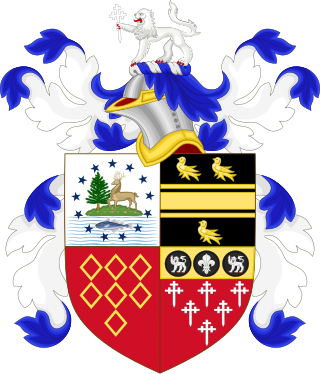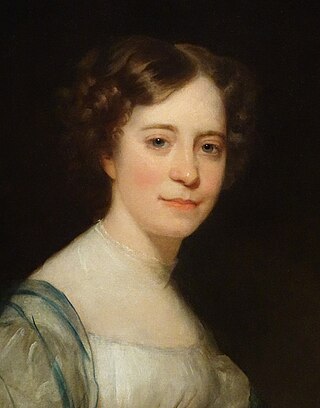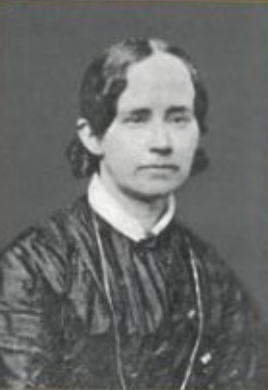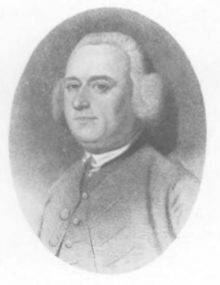
Abigail Adams was the wife and closest advisor of John Adams, the second president of the United States, and the mother of John Quincy Adams, the sixth president of the United States. She was a founder of the United States, and was both the first second lady and second first lady of the United States, although such titles were not used at the time. She and Barbara Bush are the only two women in American history who were both married to a U.S. president and the mother of a U.S. president.

Elizabeth Palmer Peabody was an American educator who opened the first English-language kindergarten in the United States. Long before most educators, Peabody embraced the premise that children's play has intrinsic developmental and educational value.

Charles Francis Adams Sr. was an American historical editor, writer, politician, and diplomat. As United States Minister to the United Kingdom during the American Civil War, Adams was crucial to Union efforts to prevent British recognition of the Confederate States of America and maintain European neutrality to the utmost extent. Adams also featured in national and state politics before and after the Civil War.

William Dawes Jr. was an American soldier, and was one of several men who, in April 1775, alerted minutemen in Massachusetts of the approach of British regulars prior to the battles of Lexington and Concord at the outset of the American Revolution. For some years, Paul Revere had the most renown for his ride of warning of this event.

The Boston Brahmins or Boston elite are members of Boston's historic upper class. In the late 19th century through the mid-20th century, they were often associated with a cultivated New England accent, Harvard University, Anglicanism, and traditional British-American customs and clothing. Descendants of the earliest English colonists are typically considered to be the most representative of the Boston Brahmins. They are considered White Anglo-Saxon Protestants (WASPs).

The Adams family is a political family in the United States most prominent between the late 18th century and the early 20th century. Based in eastern Massachusetts, they formed part of the Boston Brahmin community. The family traces to Henry Adams of Barton St David, Somerset, in England. Its members include U.S. presidents John Adams and John Quincy Adams. The two presidents and their descendants are also descended from John Alden, who came to the United States on the Mayflower.

William Cranch was a United States circuit judge and chief judge of the United States Circuit Court of the District of Columbia. A staunch Federalist and nephew of President John Adams, Cranch moved his legal practice from Massachusetts to the new national capital, where he became one of three city land commissioners for Washington, D.C., and during his judicial service also was the 2nd Reporter of Decisions of the Supreme Court of the United States and a Professor of law at Columbian College.

Sophia Amelia Hawthorne was an American painter and illustrator as well as the wife of author Nathaniel Hawthorne. She also published her journals and various articles.

Royall Tyler was an American jurist, teacher and playwright. He was born in Boston, graduated from Harvard University in 1776, and then served in the Massachusetts militia during the American Revolution. He was admitted to the bar in 1780, became a lawyer, and fathered eleven children. In 1801, he was appointed a Justice of the Vermont Supreme Court. He wrote a play, The Contrast, which was produced in 1787 in New York City, shortly after George Washington's inauguration. It is considered the first American comedy. Washington attended the production, which was well-received, and Tyler became a literary celebrity.
Nathaniel Peabody was an American physician and dentist from Boston and Salem, Massachusetts, having studied at Dartmouth College in the class of 1800. Peabody was described as an "experimentally minded doctor and dentist". He began his medical practice using "heroic" practices of large amounts of emetic and purgative medicines. For instance, a patient could become very sick or die from mercury poisoning of a purgative called calomel. Upon becoming familiar with the work of Dr. Samuel Hahnemann, Peabody used botanical medicines in small doses to treat his patients, which reduced the side effects and potential death from the heroic practices.
Isaac Bissell was a patriot post rider who delivered mail between Boston and Hartford, Connecticut. On April 19, 1775, the British made an attack on Lexington and Concord, igniting the American Revolutionary War. He was assigned to alert American colonists of the news and rally them to assist the Massachusetts minutemen. Traveling from Watertown, Massachusetts, on the Upper Post Road to Hartford, Connecticut, and through Connecticut Colony, he carried the Lexington Alarm message from Joseph Palmer. He rode again in July 1779 to deliver the New Haven Alarm. Bissell served the Connecticut Militia throughout the Revolutionary War.
Peabody is a surname, and may refer to:

The Lexington Alarm announced, throughout the American Colonies, that the Revolutionary War began with the Battle of Lexington and the Siege of Boston on April 19, 1775. The goal was to rally patriots at a grass roots level to fight against the British Redcoats and support the minutemen of the Massachusetts militia.

Thomas Boylston Adams was the third and youngest son of second United States president John Adams and Abigail (Smith) Adams. He worked as a lawyer, a secretary to his brother John Quincy Adams while the latter served as United States ambassador to the Netherlands and Prussia, the business manager of and a contributor to the political and literary journal Port Folio, and a Massachusetts chief justice.

Germantown is a primarily residential neighborhood in the city of Quincy, Massachusetts. The neighborhood is located on a peninsula surrounded by Town River bay on the west and Rock Island Cove on the east. This peninsula was known since the 1640s as “Shed's Neck”.

The Quincy family was a prominent political family in Massachusetts from the mid-17th century through to the early 20th century. It is connected to the Adams political family through Abigail Adams.

Mary Tyler Mann was an American teacher, author, and reformer. Mary was one of three Peabody sisters who were influential women of their day in education, literature, and art. Like her sister Elizabeth, she was a leader in education reform and establishment of kindergartens. Sophia was an artist and the wife of Nathaniel Hawthorne. Mary was a participant in the Transcendentalism Movement. She was an abolitionist. She supported the work of her husband Horace Mann, an American education reformer and politician, as well as Henry David Thoreau, Nathaniel Hawthorne, and Sarah Winnemucca.

The Captain William Smith House is a historic American Revolutionary War site in Lincoln, Massachusetts, United States. Part of today's Minute Man National Historic Park, it is associated with the revolution's first battle, the 1775 battles of Lexington and Concord. Believed to have been built in 1692, in what was then Concord, it is believed to be the oldest house in Lincoln.
William Smith was a captain of the minutemen of Lincoln, Province of Massachusetts Bay, during the battles of Lexington and Concord, which began the American Revolutionary War.
Israel Bissell, also spelled Bissel, was a patriot post rider who delivered mail between Boston, Massachusetts and New York.




















